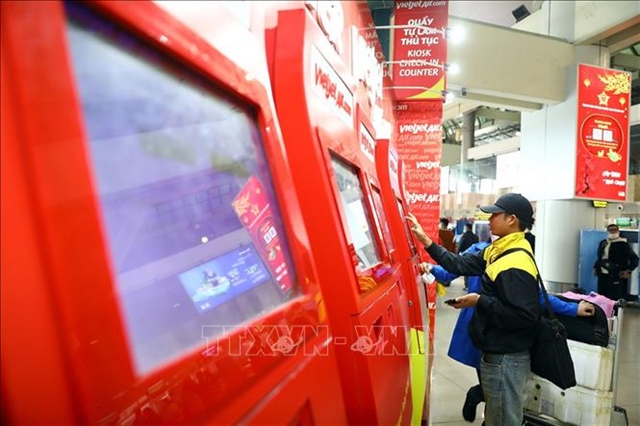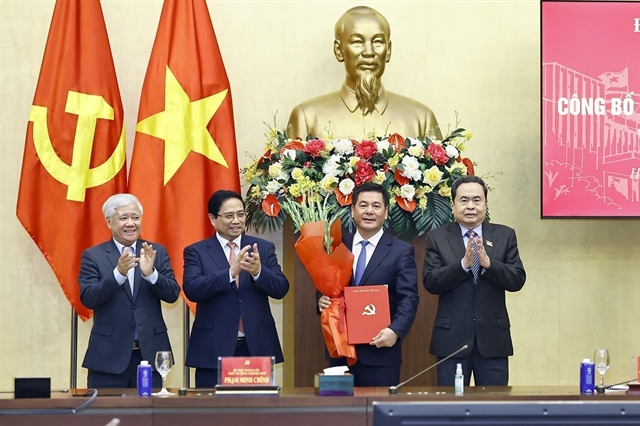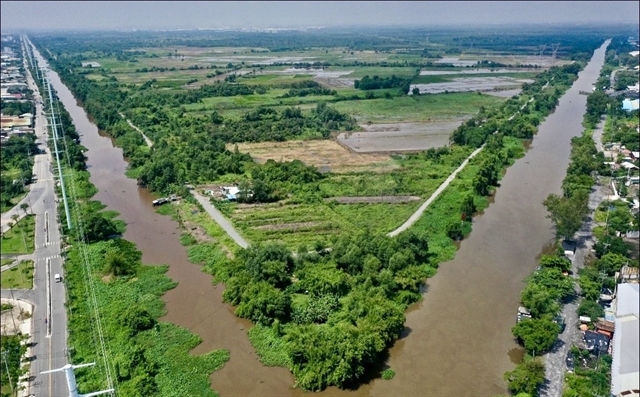 Economy
Economy


|
| A passenger at an automated check-in kiosk at Nội Bài International Airport. Ceiling airfares will be increased from March 2024. — VNA/VNS Photo Huy Hùng |
HÀ NỘI — The Ministry of Transport has issued a circular which will increase ceiling airfares for domestic routes from March 1, 2024, after the peak travel time of Tết (Lunar New Year) holidays, in the context that domestic airlines are under post-COVID-19 financial pressure
Accordingly, the ceiling airfare for routes of below 500 km would be kept the same at VNĐ1.6 million per one-way ticket and VNĐ1.7 million for routes serving socio-economic development.
For routes of 500-850 km, the ceiling airfare is increased from VNĐ2.2 million to VNĐ2.25 million.
The ceiling airfare for routes of 850-1,000km is increased by VNĐ100,000 to VNĐ2.89 million.
The increase for the routes of 1,000-1,200 km is VNĐ200,000 to VNĐ3.4 million per one-way ticket.
For routes from 1,280 km, the ceiling fare is VNĐ4 million, an increase of VNĐ250,000.
The ceiling fares include all costs the passenger must pay for airline tickets, excluding value added tax and fees collected on behalf of airports.
Accordingly, the golden route of Hà Nội – HCM City would have the highest fare of VNĐ3.4 million per one-way ticket and VNĐ4 million for Hà Nội – Phú Quốc.
Bùi Doãn Nề, Deputy President of Việt Nam Aviation Business Association said domestic airlines currently offered a diversity of airfares to ensure suitableness to a wide range of customers. However, there are caps on airfares set by the Government.
There are absolutely no exclusive flight routes on the market and buyers can easily access domestic air transport services with many options, Nề said, urging consideration on lifting caps on airfares in the long run to ensure market-based pricing.
Prolonged COVID-19 impacts
Rising input costs are weighing on profits of domestic airlines despite recovery in revenue after the COVID-19 pandemic, pushing them into financial difficulty.
“Domestic airlines see recoveries in revenues but the sharp increase in input costs undermines their profits, which makes it difficult to recover the accumulated losses incurred during the pandemic,” Nề said.
According to a representative of Vietnam Airlines jet fuel accounts for about 36 per cent of the transportation costs of carriers.
In 2023, jet fuel prices are projected to be at around US$112 per barrel. Every increase of $1 will push up fuel cost by VNĐ224 billion (US$9.2 million),
Average jet fuel price in 2023 rose by 58.6 per cent against 2015 – the year when the existing airfare framework was set.
Vietnam Airlines estimated that its expense for jet fuel this year would be VNĐ6.2 trillion higher than pre-pandemic 2019.
In addition, 70 per cent of payments for operation for airlines are made in foreign currencies while the ticket sales are in Vietnamese đồng, which means that the exchange rate between the US dollar and the Vietnamese đồng significantly affects airlines’ profits.
Statistics showed that the exchange rate increased by 9 per cent, from VNĐ21,900 buying a dollar in 2015 to VNĐ23,900 in 2023, creating huge pressure on airfares. Currencies of major markets of domestic carriers such as Japan and the Republic of Korea are also strengthening.
The third quarter financial report of Vietnam Airlines showed that the revenue of Vietnam Airlines increased by 32.3 per cent in January – September. However, the carrier estimated a loss of VNĐ4.5 trillion in 2023.
A representative from Vietravel Airlines said that exchange rates and fuel prices jumping beyond forecasts, coupled with debt repayment pressures were pushing domestic airlines into financial exhaustion. Implemented solutions such as cutting costs could not change the situation.
Although official statistics showed that the number of foreign arrivals to Việt Nam increased compared to last year, the increase is far below what was projected as consumers tighten spending on the impact of global economic slowdown.
According to Director of the Civil Aviation Authority of Việt Nam Đinh Việt Thắng, below-expectation recovery of major markets such as Japan, the Republic of Korea and China significantly affects revenues and profits of airlines.
Some opened new flight routes to Australia and India, for example, in an attempt to boost revenue, but the slots to these two markets are all occupied, meaning that the ability to increase revenue through the increase in flight frequency in at least six coming months is modest.
Besides the slow recovery of the international market, the demand in the domestic market is also dropping.
In the last three months of this year, the total transportation capacity of airlines increased by 15.2 per cent over the same period last year, but the total number of passengers only increased by 7.4 per cent.
Some domestic airlines are narrowing down their fleets, including Vietravel Airlines from six aircraft to 3 and Bamboo Airways from 30 to 17.
Nề forecast airlines would continue to face challenges in 2024, from jet fuel prices, exchange rates and the recoveries of major foreign markets.
He urged the Government to provide support to the aviation industry, especially solutions to promote tourism next year. — VNS




